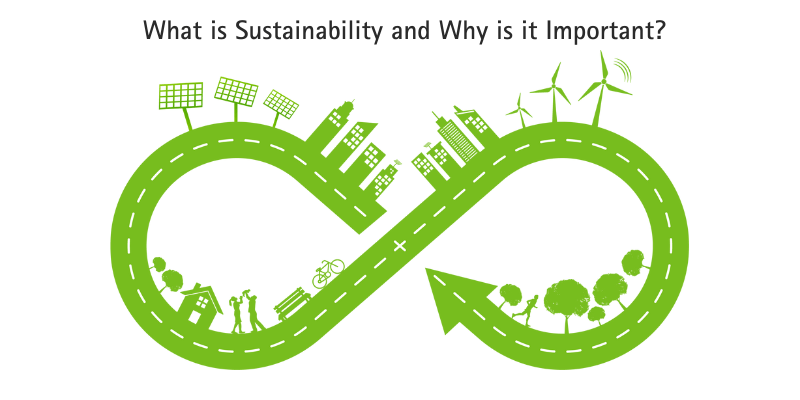What is Sustainability and Why is it Important?
Welcome to our exploration of one of the most crucial concepts shaping our world today: Sustainability. This term, often tossed around in discussions ranging from corporate boardrooms to grassroots movements, holds the key to our collective future. But what exactly is sustainability, and why does it warrant such significant attention? In this insightful journey, we will delve into the multifaceted nature of sustainability, unravelling its definition and the intricate ways it intertwines with every aspect of our lives.
From environmental conservation to economic and social equity, understanding sustainability is not just about grasping a buzzword; it's about recognising our role in a complex ecosystem where every action has a profound impact.
Join us as we uncover why sustainability is essential for our planet's and future generations' survival and prosperity.
What is Sustainability?
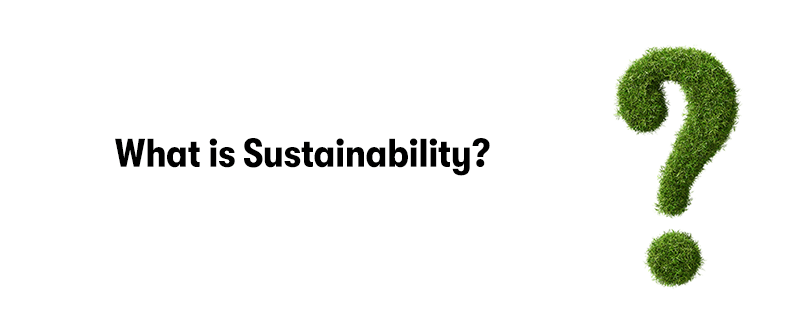
Sustainability refers to the practice of meeting our current needs without compromising the ability of future generations to meet their own needs. It encompasses a broad range of issues and practices, often focusing on three main pillars:
Environmental Sustainability
This involves protecting and managing natural resources effectively, reducing pollution, and mitigating climate change. Practices like recycling, renewable energy usage, and conservation of ecosystems fall under this category.
Economic Sustainability
This aspect ensures that economic activities can be sustained long-term without causing harm to the environment or society. It involves responsible resource management, fair economic opportunities, and sustainable business practices.
Social Sustainability
This focuses on maintaining and improving social equality, quality of life, and community well-being. It includes issues like human rights, labour rights, and social justice.
The concept of sustainability is rooted in an understanding that everything we need for our survival and well-being depends, either directly or indirectly, on our natural environment and that there is a need to balance as we advance economically and socially.
Why is it Important to be Sustainable in Business?
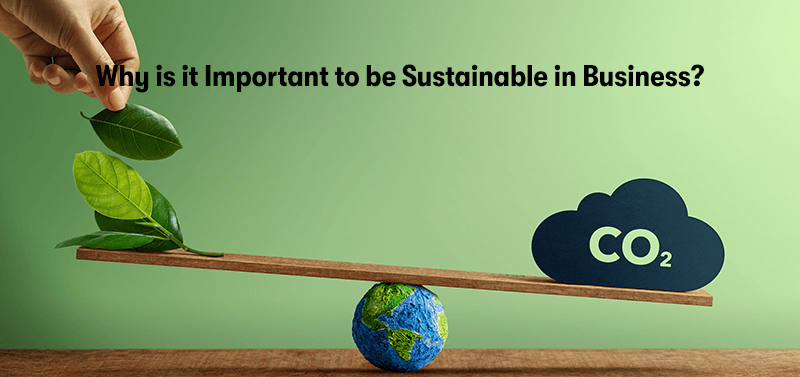
Sustainability in business is crucial for several reasons, reflecting its benefits not only to the environment and society but also to the businesses themselves:
Long-Term Viability
Sustainable practices ensure that natural resources, which businesses depend on, are used responsibly, and conserved for future use. This long-term approach helps businesses remain viable in a world with finite resources.
Regulatory Compliance and Risk Management
Increasingly, governments are implementing environmental regulations. Businesses proactively adopting sustainable practices are better positioned to comply with these regulations, avoiding fines and legal issues. Moreover, sustainable practices can mitigate risks associated with resource scarcity and climate change.
Financial Performance and Efficiency
Sustainable business practices often lead to cost savings. Energy-efficient operations, waste reduction, and sustainable sourcing can lower operational costs. Sustainable practices can open up new revenue streams, like recycling or sustainable product lines.
Customer and Stakeholder Demand
There is a growing demand from consumers, employees, and investors for sustainable practices. Companies that demonstrate a commitment to sustainability can enhance their brand image, attract and retain talent, and appeal to socially conscious investors.
Innovation and Competitive Advantage
The drive towards sustainability can inspire innovation, leading to the development of new, more efficient products and processes. This innovation can provide a competitive edge in the marketplace.
Social Responsibility and Ethical Considerations
Businesses, as part of society, have a responsibility to operate ethically. This includes considering the social and environmental impacts of their operations. Sustainable practices demonstrate a commitment to ethical operations.
Global Challenges and Opportunities
Businesses play a crucial role in addressing global challenges like climate change, resource depletion, and social inequality. By adopting sustainable practices, businesses can contribute positively to these global issues, often finding new opportunities in the process.
Overall, sustainability in business is not just about being responsible stewards of the environment and society but also about ensuring the longevity, resilience, and success of the business itself in a rapidly changing world.
What are the Benefits of Being Sustainable in Business?
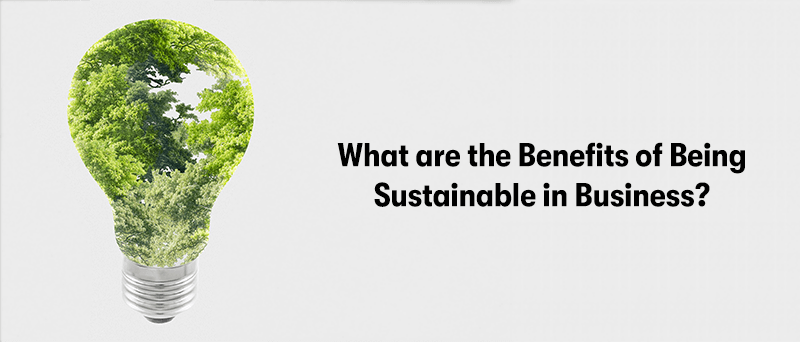
Being sustainable in business offers numerous benefits that can positively impact the environment, society, and the business itself. Here are some key advantages:
Cost Reduction
Implementing sustainable practices leads to significant cost savings. This can be achieved through more efficient use of resources, such as energy, water, and materials, and waste reduction. For example, using energy-efficient appliances and lighting, reducing water waste, and minimising material usage can lower utility bills and operational costs.
Improved Brand Image and Competitive Advantage
Consumers are increasingly conscious of the environmental and social impact of the products and services they use. Businesses that are recognised for their sustainable practices enjoy a stronger brand image and reputation. This can lead to increased customer loyalty, a competitive edge in the market, and the ability to attract new customers who prioritise sustainability.
Increased Employee Satisfaction and Retention
Many employees prefer to work for companies that demonstrate a commitment to environmental and social responsibility. This can increase job satisfaction, employee morale, and retention rates. It also makes the company more attractive to potential new hires.
Access to New Markets and Customers
Sustainability can open up new business opportunities. For example, developing eco-friendly products or services can attract customers who are specifically looking for sustainable options. This can also help businesses enter new markets where sustainability is a key purchasing factor.
Risk Management and Resilience
Sustainable practices can help businesses manage risks associated with environmental regulations, resource scarcity, and climate change impacts. By proactively addressing these issues, companies can avoid potential fines, supply chain disruptions, and other risks associated with unsustainable practices.
Innovation and Long-term Growth
The pursuit of sustainability often drives innovation. It encourages businesses to think creatively about how they produce and deliver their products and services. This can lead to the development of new, more efficient, and more sustainable methods of operation, fostering long-term growth.
Attracting Investors
An increasing number of investors are considering environmental, social, and governance (ESG) factors when making investment decisions. Companies performing well in these areas can attract investment from socially conscious investors.
Positive Community and Societal Impact
Sustainable businesses contribute positively to the communities and societies in which they operate. This can be through environmentally friendly practices that protect the local environment or through social initiatives that support local communities.
Regulatory Compliance
With governments worldwide increasingly imposing regulations on environmental and social practices, being proactive in sustainability can ensure compliance and avoid legal and financial penalties.
Enhanced Supply Chain Sustainability
Businesses focusing on sustainability often work to make their supply chains more sustainable. This can improve efficiency, reduce costs, and better supplier relationships.
In summary, sustainability in business can lead to cost savings, enhanced brand value, improved employee morale, access to new markets, innovation, risk mitigation, and a positive impact on society and the environment. These benefits contribute to the long-term success and resilience of the business.
What are the Three Pillars of Sustainability?
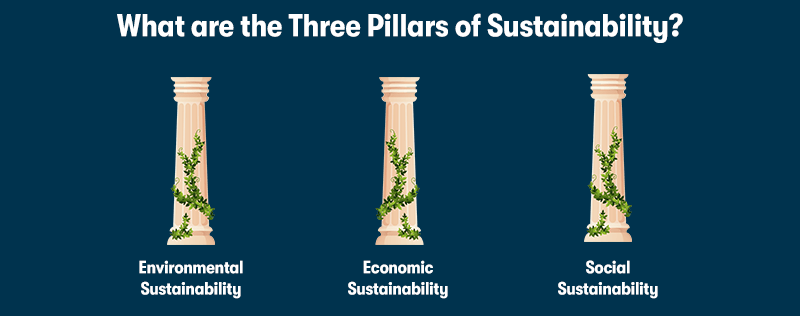
The three pillars of sustainability, also known as the triple bottom line, are:
Environmental Sustainability
This pillar focuses on conserving natural resources and reducing the environmental impact of activities. It includes reducing carbon emissions, conserving water, managing waste effectively, and preserving biodiversity. The goal is to protect and maintain the natural environment for future generations.
Economic Sustainability
Economic sustainability involves practices that support long-term economic growth without negatively impacting the community's social, environmental, and cultural aspects. It emphasises the need for businesses and societies to be efficient, resourceful, and innovative to ensure ongoing economic development and prosperity.
Social Sustainability
This pillar is about maintaining and improving social quality of life, equity, and community well-being. It includes issues like human rights, labour rights, social justice, and community development. The aim is to create an equitable society that meets the needs of its members, including health, education, and employment opportunities, while maintaining cultural integrity and social cohesion.
These three pillars are interconnected, and sustainable development aims to balance these aspects to achieve long-term viability and health of both human and ecological systems.
What are the Sustainable Development Goals (SDGs)?
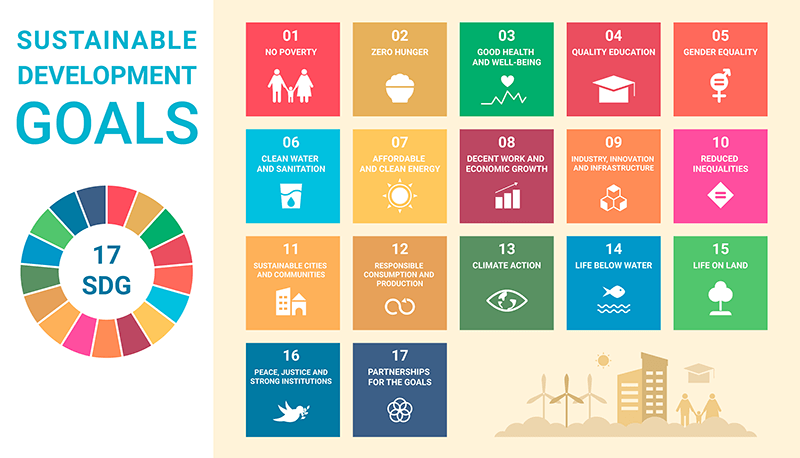
The Sustainable Development Goals (SDGs) are a universal set of goals, targets, and indicators adopted by the United Nations in 2015 as part of the 2030 Agenda for Sustainable Development. The SDGs are designed to guide global efforts in tackling the world's most pressing challenges, including poverty, inequality, climate change, environmental degradation, peace, and justice. There are 17 goals in total, each with specific targets to be achieved by 2030. These goals are:
No Poverty
End poverty in all its forms everywhere.
Zero Hunger
End hunger, achieve food security and improved nutrition, and promote sustainable agriculture.
Good Health and Well-being
Ensure healthy lives and promote well-being for all at all ages.
Quality Education
Ensure inclusive and equitable quality education and promote lifelong learning opportunities for all.
Gender Equality
Achieve gender equality and empower all women and girls.
Clean Water and Sanitation
Ensure availability and sustainable management of water and sanitation for all.
Affordable and Clean Energy
Ensure access to affordable, reliable, sustainable, and modern energy for all.
Decent Work and Economic Growth
Promote sustained, inclusive, and sustainable economic growth, full and productive employment, and decent work for all.
Industry, Innovation, and Infrastructure
Build resilient infrastructure, promote inclusive and sustainable industrialisation, and foster innovation.
Reduced Inequality
Reduce inequality within and among countries.
Sustainable Cities and Communities
Make cities and human settlements inclusive, safe, resilient, and sustainable.
Responsible Consumption and Production
Ensure sustainable consumption and production patterns.
Climate Action
Take urgent action to combat climate change and its impacts.
Life Below Water
Conserve and sustainably use the oceans, seas, and marine resources for sustainable development.
Life on Land
Protect, restore, and promote sustainable use of terrestrial ecosystems, sustainably manage forests, combat desertification, and halt and reverse land degradation and halt biodiversity loss.
Peace, Justice, and Strong Institutions
Promote peaceful and inclusive societies for sustainable development, provide access to justice for all, and build effective, accountable, and inclusive institutions at all levels.
Partnerships for the Goals
Strengthen the means of implementation and revitalise the global partnership for sustainable development.
These goals are interconnected and are designed to balance social, economic, and environmental sustainability. Achieving the SDGs requires the collaboration and partnership of governments, the private sector, civil society, and individuals worldwide.
What are the Planetary Boundaries for Sustainability?
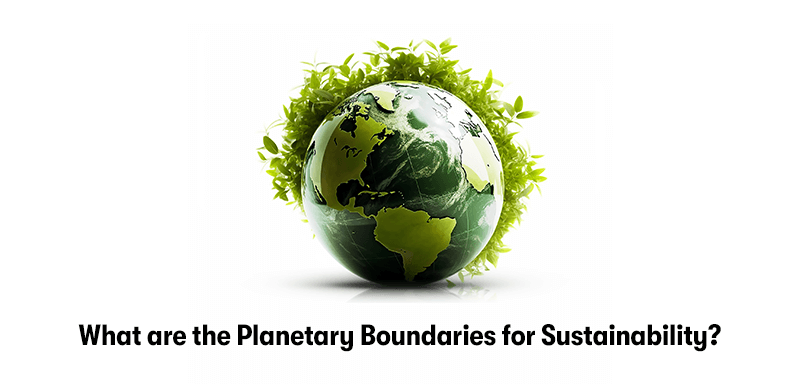
The concept of planetary boundaries, introduced by a group of Earth system and environmental scientists led by Johan Rockström from the Stockholm Resilience Centre and Will Steffen from the Australian National University, identifies critical limits to the Earth's key environmental systems. These boundaries are thresholds which, if crossed, could result in irreversible and abrupt environmental changes. The framework is designed to define a "safe operating space" for humanity that avoids significant damage to the Earth's life-support systems. As of my last update, there are nine identified planetary boundaries:
Climate Change
This boundary refers to the concentration of greenhouse gases in the atmosphere. Crossing this boundary could lead to severe climate disruption.
Biodiversity Integrity (Biosphere Integrity)
This involves the loss of biodiversity and species extinction. High extinction rates and loss of ecosystem integrity diminish Earth's resilience and adaptive capacity.
Biogeochemical Flows
This includes the human-driven perturbation of the nitrogen and phosphorus cycles, crucial for ecosystem functioning. Excessive use of these nutrients leads to severe environmental issues like algal blooms and dead zones in water bodies.
Ocean Acidification
Increased CO2 levels are causing the oceans to become more acidic, affecting marine ecosystems, particularly coral reefs and shellfish.
Land-System Change
This refers to the transformation of land from natural states (like forests) into agricultural or urbanised states. It impacts biodiversity, climate, and biogeochemical cycles.
Freshwater Use
Overuse and pollution of freshwater resources can lead to water scarcity and degradation of aquatic ecosystems.
Atmospheric Aerosol Loading
This involves the impact of microscopic particles in the atmosphere on Earth's climate system and living organisms. Aerosols can influence climate and air quality.
Stratospheric Ozone Depletion
The thinning of the stratospheric ozone layer is due to chemical pollutants like CFCs, which protect the Earth from harmful ultraviolet radiation.
Novel Entities
This includes chemical pollution and other new materials or organisms that humans have introduced into the environment, such as plastics, heavy metals, and radioactive materials, whose long-term impacts are often unknown.
These boundaries are not only environmental issues but also represent a challenge for sustainable development. Crossing these boundaries could have severe consequences for humanity, including reduced access to clean water, clean air, and stable climates, all of which are essential for human health and well-being. The concept emphasises the need for integrated approaches that balance economic development with preserving Earth's critical systems.
What is a Sustainability Plan?
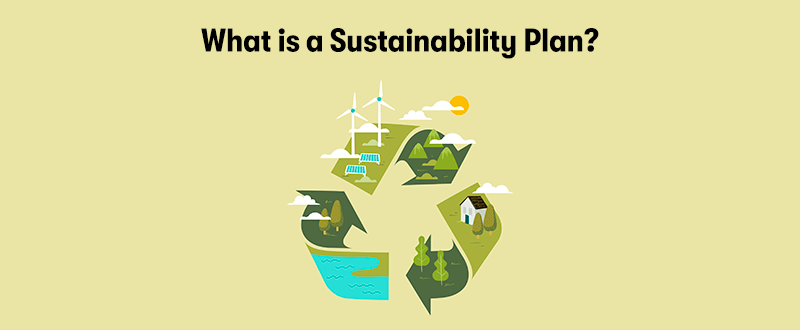
A sustainability plan is a strategic document that outlines an organisation's approach to addressing sustainability-related issues, including environmental, social, and economic aspects. The plan typically includes goals, strategies, and specific actions the organisation intends to implement to become more sustainable. Key features of a sustainability plan include:
Vision and Objectives
The plan starts with a clear vision of what the organisation aims to achieve regarding sustainability. This is followed by specific, measurable objectives that align with this vision.
Assessment of Current Impact
An evaluation of the organisation's operations' current environmental, social, and economic impacts. This might include energy usage, waste generation, water consumption, social influences on communities, and economic factors like job creation and economic growth.
Key Areas of Focus
Identification of key areas where the organisation can have the most significant impact. This could include energy efficiency, reducing carbon footprint, sustainable sourcing, improving labour practices, community engagement, etc.
Strategies and Actions
Detailed strategies and action plans for achieving the objectives. This might include implementing new technologies, changing operational practices, employee training programs, stakeholder engagement plans, and more.
Performance Metrics
Establishing metrics to measure progress towards the sustainability goals. These metrics allow the organisation to track its performance and adjust as needed.
Timeline
A defined timeline for implementing various plan elements and achieving the set goals.
Stakeholder Engagement
Involving stakeholders, including employees, customers, suppliers, and the local community, in developing and implementing the plan. This can increase buy-in and support for the initiatives.
Reporting and Communication
Regularly reporting on progress towards the sustainability goals, both internally to employees and externally to stakeholders and the public. Transparency in communication is key.
Continuous Improvement
The plan should be a living document, subject to review and adjustment as circumstances change and as the organisation learns from its sustainability initiatives.
A sustainability plan is important for any organisation looking to reduce its environmental footprint, contribute positively to society, and ensure long-term economic viability. It demonstrates a commitment to responsible and ethical business practices and can help an organisation manage risks, improve efficiency, enhance its reputation, and drive innovation.
What is Digital Sustainability?
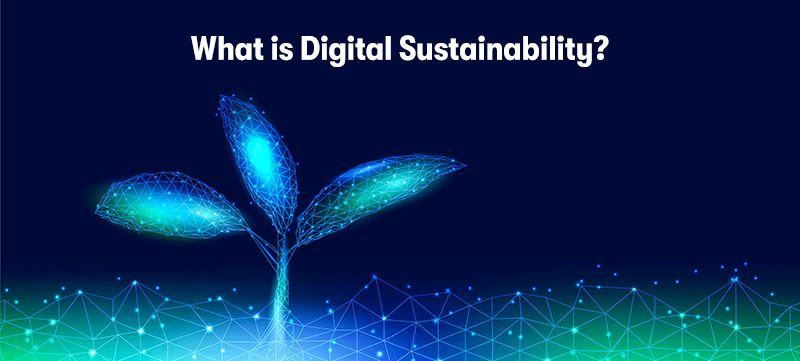
Digital sustainability refers to the practice of designing, using, and disposing of digital technologies in a way that supports and enhances overall sustainability goals. This concept encompasses a broad range of activities and considerations that extend across the entire lifecycle of digital technologies, from their creation to their disposal. Key aspects of digital sustainability include:
Energy Efficiency
One of the primary concerns in digital sustainability is the energy consumption of digital infrastructure, including data centres, network systems, and end-user devices. Energy efficiency measures, such as using renewable energy sources, improving data centre cooling technologies, and designing energy-efficient hardware, are crucial.
Resource Management
This involves the responsible sourcing of materials used in producing electronic devices and efficient manufacturing processes. It also includes the recycling and repurposing of electronic waste to reduce the environmental impact associated with the disposal of tech products.
Software Sustainability
Sustainable software design aims to create efficient software in terms of resource usage, such as requiring less computational power or memory. This reduces the energy required to run the software and extends the hardware's lifespan.
Digital Inclusion and Accessibility
Ensuring digital technologies are accessible and beneficial to a wide range of users, including those in underserved or marginalised communities. Digital sustainability includes bridging the digital divide and promoting equitable access to technology.
Data Management and Privacy
Responsible handling of data, including efficient data storage, data minimisation, and ensuring privacy and security of user data. Efficient data management can reduce the energy required for data storage and processing.
Lifecycle Approach
Considering the environmental impact of digital technologies throughout their entire lifecycle, from design and manufacturing to use and end-of-life disposal. This approach seeks to minimise the overall environmental footprint of technology.
Sustainable Business Models
Developing business models that support the long-term sustainability of digital products and services. This could include models that encourage product longevity, repairability, and recycling.
Green IT Policies
Implementing organisational policies that promote the use of sustainable technologies and practices within the workplace.
Digital sustainability is increasingly important as the digital economy grows and technology becomes more integral to all aspects of life. Organisations and individuals can help mitigate technology's environmental impact by focusing on digital sustainability while promoting social and economic benefits.
Where Can You Learn More About Digital Sustainability?
At Purple Griffon, we offer an ITIL® 4 Specialist Sustainability in Digital & IT (SDIT) training course. This course will help you to:
- Understand how to use the ITIL guiding principles to deliver value by creating sustainable digitally enabled products and services.
- Effectively address VUCA challenges through sustainable strategies, procurement, products and practices.
- Obtain a practical grounding in the key principles of sustainability.
- Conduct a complete cost-benefit analysis identifying potential risks and opportunities using best practice guidance.
Final Notes on Sustainability and Its Importance
In conclusion, our journey through the expansive realm of sustainability has been enlightening and multifaceted. We've explored the essence of sustainability and its significance in the business world, delving into the advantages of sustainable practices. Understanding the three pillars of sustainability—environmental, economic, and social—helps frame our approach to sustainable development. The Sustainable Development Goals (SDGs) and the concept of planetary boundaries further underscore the urgency and scope of our global sustainability challenges.
We also discussed the importance of having a sustainability plan in organisations and the emerging concept of digital sustainability. As we continue to navigate these critical topics, it's clear that sustainability is not just a trend but a fundamental approach to ensuring a thriving future for our planet and its inhabitants.


